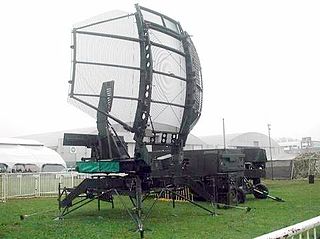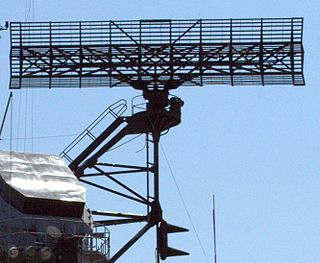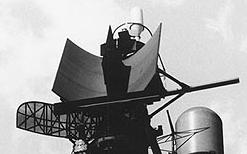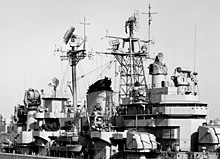
Radar is a detection system that uses radio waves to determine the distance (ranging), angle, and radial velocity of objects relative to the site. It can be used to detect aircraft, ships, spacecraft, guided missiles, motor vehicles, weather formations, and terrain. A radar system consists of a transmitter producing electromagnetic waves in the radio or microwaves domain, a transmitting antenna, a receiving antenna and a receiver and processor to determine properties of the objects. Radio waves from the transmitter reflect off the objects and return to the receiver, giving information about the objects' locations and speeds.

An active electronically scanned array (AESA) is a type of phased array antenna, which is a computer-controlled array antenna in which the beam of radio waves can be electronically steered to point in different directions without moving the antenna. In the AESA, each antenna element is connected to a small solid-state transmit/receive module (TRM) under the control of a computer, which performs the functions of a transmitter and/or receiver for the antenna. This contrasts with a passive electronically scanned array (PESA), in which all the antenna elements are connected to a single transmitter and/or receiver through phase shifters under the control of the computer. AESA's main use is in radar, and these are known as active phased array radar (APAR).

A pulse-Doppler radar is a radar system that determines the range to a target using pulse-timing techniques, and uses the Doppler effect of the returned signal to determine the target object's velocity. It combines the features of pulse radars and continuous-wave radars, which were formerly separate due to the complexity of the electronics.

An airport surveillance radar (ASR) is a radar system used at airports to detect and display the presence and position of aircraft in the terminal area, the airspace around airports. It is the main air traffic control system for the airspace around airports. At large airports it typically controls traffic within a radius of 60 miles (96 km) of the airport below an elevation of 25,000 feet. The sophisticated systems at large airports consist of two different radar systems, the primary and secondary surveillance radar. The primary radar typically consists of a large rotating parabolic antenna dish that sweeps a vertical fan-shaped beam of microwaves around the airspace surrounding the airport. It detects the position and range of aircraft by microwaves reflected back to the antenna from the aircraft's surface. The secondary surveillance radar consists of a second rotating antenna, often mounted on the primary antenna, which interrogates the transponders of aircraft, which transmits a radio signal back containing the aircraft's identification, barometric altitude, and an emergency status code, which is displayed on the radar screen next to the return from the primary radar.
Type 354 Radars are one of the most widely deployed air and surface search naval radars in Chinese service. The Type 354 was predominantly found on major People's Liberation Army Navy (PLAN) surface combatants such as the Luda class destroyer and Jianghu class frigate in the 1980s and 1990s. By 2006 it was slowly being replaced in favour of the Type 360 radar, which in turn, itself being replaced by Type 364 radar for new vessels.

The Type 345 (MR35) fire-control radar system is used to guide the HQ-7 short-range surface-to-air missile. The system is installed on many modern, and retrofitted Chinese navy ships.

The AN/TPS-43 is a transportable air search 3D radar produced in the United States originally by Westinghouse Defense and Electronic Division, which was later purchased by Northrop-Grumman. It is used primarily for early warning and tactical control, often for control over an associated surface-to-air missile battery or airfield. It is designed to be transported in two M35 cargo trucks and easily air-transportable on two pallets.

The AN/SPS-48 is a US naval electronically scanned array air search three-dimensional radar system manufactured by ITT Exelis and deployed in the 1960s as the primary air search sensor for anti-aircraft warships. The deployment of the AN/SPY-1 and the end of the Cold War led to the decommissioning of many such ships, and many of these vessels AN/SPS-48 sets were reused on aircraft carriers and amphibious ships, where it is used to direct targets for air defense systems such as the Sea Sparrow and RIM-116 SAM missiles. Existing sets are being modernized under the ROAR program to AN/SPS-48G standard for better reliability and usability.

The AN/SPS-49 is a United States Navy two-dimensional, long range air search radar built by Raytheon that can provide contact bearing and range. It is a primary air-search radar for numerous ships in the U.S. fleet and in Spain, Poland, Taiwan aboard Oliver Hazard Perry-class frigates, Canada on its Halifax-class frigate and New Zealand on its Anzac-class frigates. It formerly served in a complementary role aboard Aegis cruisers with the AN/SPY-1 but the systems are currently being removed during routine upgrade with no replacement.

The Saab Giraffe Radar is a family of land and naval two- or three-dimensional G/H-band passive electronically scanned array radar-based surveillance and air defense command and control systems tailored for operations with medium- and Short Range Air Defense (SHORAD) missile or gun systems or for use as gap-fillers in a larger air defense system. The radar gets its name from the distinctive folding mast which when deployed allows the radar to see over nearby terrain features such as trees, extending its effective range against low-level air targets. The first systems were produced in 1977. By 2007, some 450 units of all types are reported as having been delivered.

The AN/SPS-67 is a short-range, two-dimensional, surface-search/navigation radar system that provides highly accurate surface and limited low-flyer detection and tracking capabilities.

The AN/SPS-43 was a long-range air-search United States Navy radar system introduced in March 1961 that had a range of 500+ km. This radar could provide bearing and distance information, but no altitude information. The small-ship antenna (AN/SPS-29) looked like a bedspring. Larger ships used the 12.8 m wide AN/SPS-37 antenna - about twice as wide and half the height of the SPS-29 antenna - and designed with a much narrower beam. Targets were much more accurately displayed when using the -37 antenna. The -43 operated at VHF frequency - somewhat unusual for any radar - mostly in the bandwidth of television channel 13. The main difference to the SPS-37 was the greatly improved ECCM performance, as the AN/SPS-43 could jump between 20 different frequencies to frustrate jamming attempts. A sea-skimming missile could be detected at a range distance of 30 km, a large high-flying aircraft at 500 km.

The Type 965 radar was VHF long-range aircraft warning radar used by warships of the Royal Navy from the 1960s onwards. The Type 965M, Type 965P, Type 965Q and Type 965R were improved versions; the Type 960, 965M and 965Q used the single bedstead AKE(1) aerial, whilst the Type 965P and 965R used the double bedstead AKE(2) aerial.

OPS-14 is a two-dimensional radar manufactured by Mitsubishi Electric. It is mainly mounted on the Maritime Self-Defense Force's self-defense ship as an anti-aircraft search radar. Variations include OPS-14B and OPS-14C.

AN/SPS-6 is a two-dimensional radar manufactured by Bendix and Westinghouse Electric. It was used by the US Navy as a first-generation air-search radar after World War II, and was widely exported to allies. In addition, the improved AN/SPS-12 is the derivative types developed in other countries.

AN/SPS-10 is a two-dimensional radar manufactured by Raytheon Technologies. It was used by the US Navy as a surface-search radar after World War II, and was equipped aboard naval ships during the Cold War. Variants include AN/SPS-10B, AN-SPS/10E and AN/SPS-10F.

AN/SPS-29 is a two-dimensional radar that was manufactured by General Electric. It was used by the US Navy as a early warning radar after World War II, and was equipped aboard naval ships during the Cold War. Variants include AN/SPS-29A, AN/SPS-29B, AN/SPS-29C, AN/SPS-29D and AN/SPS-29E. After modernization, it was redesignated as AN/SPS-37.

AN/SPS-39 is a three-dimensional radar was manufactured by Hughes Aircraft Company. It was used by the US Navy as a parabolic-cylinder reflector antenna after World War II, and was equipped aboard naval ships during the Cold War. It was mass-produced based on AN/SPS-26, and was also the first 3D radar deployed by the US Navy in the fleet. It later evolved into an improved AN/SPS-52.

Mark 63 Gun Fire Control System is a gun fire-control system made up of AN/SPG-34 radar tracker and the Mark 29 gun sight. They were usually equipped for the control of twin QF 4-inch naval gun Mk XVI and Mk.33 twin 3"/50 cal guns.




















